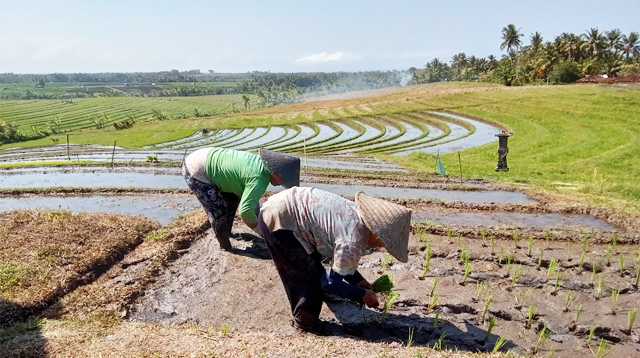PLANTING rice in Bali is not just an agricultural activity, but also a cultural tradition full of meaning and spiritual value. This tradition has been passed down from generation to generation and is an integral part of Balinese life.
Subak: Foundations of the Rice Planting Tradition
The subak system, a unique traditional irrigation cooperative in Bali, is the foundation of Bali’s rice growing tradition. Subak not only regulates water flow, but also symbolizes cooperation and mutual cooperation between farmers. Subak is guarded and preserved through various rituals and traditions, such as mepejati, , mapag toya and nangluk merana (ritual of pest and disease control).
Rituals and Ceremonies
Various rituals and traditional ceremonies color the tradition of planting rice in Bali. Starting from mepejati, the ritual of asking permission from Goddess Sri, the goddess of rice, to start the planting season. Then, ngingsah, the ritual of cleaning rice fields, and nangluk merana, a ritual of purification and repelling pests.
Planting Rice: A Togetherness
The process of planting rice in Bali is carried out jointly. The tradition of mamula, planting rice by hand, is a moment of togetherness and joy for the community. Helping each other and exchanging stories is part of this tradition.
Contained Values
The tradition of planting rice in Bali contains noble values, such as:
Togetherness and mutual cooperation: This tradition is carried out together, showing the importance of cooperation in achieving common goals. This tradition is expressed in various forms of groups such as sekaa manyi (harvesting group), sekaa mamula (planting group) and others. However, over time, one by one these groups disappeared because they were replaced by workers from outside brought in by grain buyers. Perhaps there are still some remaining, such as mamula groups which apply to their members only, if non-members they will charge daily wages for agricultural workers.
Spiritual awareness: Traditional rituals and ceremonies show gratitude and respect for Goddess Sri and the universe. Basically, rice fields are considered sacred and rice plants are also ‘treated like humans’ starting from the moment after planting where the rice is given a healing ritual, a warning of a month, two months, the rice will flower
Local wisdom: This tradition is a form of local wisdom in maintaining natural balance and environmental sustainability.
Challenges and the Future
The tradition of growing rice in Bali faces various challenges, such as:
Urbanization: Younger generations are turning to other jobs, abandoning farming traditions. Many of them have turned to the fields of tourism, finance, cruise ships and others.
Modernization: The use of modern technology is changing the traditional way of farming. Land cultivation no longer uses cows to plow, but machine tractors. For those who cannot afford to buy, they have to rent and the rental costs are quite expensive.
Climate change: The threat of rice pests and diseases is increasing. The increase in pests and diseases causes operational costs, especially purchasing pesticides, to increase. Meanwhile, climate changes sometimes have a greater impact on the availability of water for irrigation, so water is not available all year round or when farmers need it.
Preserving the tradition of growing rice in Bali is a shared responsibility. Efforts to educate the younger generation, preserve Subak, and adapt to changing times are the keys to keeping this cultural heritage alive.
The tradition of growing rice in Bali is not only about farming, but also about culture, noble values and local wisdom. Preserving this tradition means preserving the valuable cultural heritage and identity of the Balinese people.











